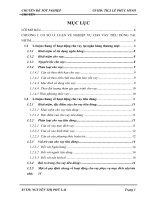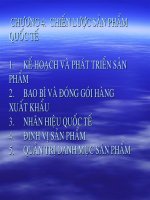02 physical props
Bạn đang xem bản rút gọn của tài liệu. Xem và tải ngay bản đầy đủ của tài liệu tại đây (1.51 MB, 16 trang )
Physical Properties of Minerals
Color, shape, density,
hardness, etc
Each mineral species has
unique and identifiable
physical properties.
•
•
•
•
•
•
•
Form and habit (Shape)
Luster
Color and Streak
Cleavage and Fracture
Hardness
Density
Tenacity
•
•
•
•
•
•
•
•
Form and Habit Terms
(Crystal Growth Forms)
Prismatic (well developed prism faces)
Columnar (Irregular prism faces)
Acicular (needle-like)
Botryoidal (rounded growth surface)
Tabular (Platey)
Stellate (Radiating)
Fibrous (fibers, asbestiform)
Dendritic (tree-like)
Acicular
Fibrous
Dendritic
Radiating
Bladed
Botryoidal
Prismatic
Radiating
Luster and Transparency
• Luster
– Metallic
– Resinous
(waxy)
– Pearly
– Greasy
– Adamantine
– Vitreous
• Transparency
– Opaque
– Translucent
– Transparent
Metallic
Adamantine
Vitreous
Pearly
Color and Streak
• The reflectance color of minerals is
strongly affected by transition metals
(V, Cr, Mn, Fe, Co, Ni, and Cu). (Also
rare earths)
• Color in hand specimen may not be
diagnostic.
• Color in streak generally indicates
presence of iron or other transition
metals.
Chatoyance, Asterism,
and Luminescence
• Chatoyance and asterism are optical
effects due to diffraction of light from
small inclusions.
• Luminescence is emission of light.
– Visible or UV (black light)
– Tribo-luminescence
– Cathodo-luminescence is emission of light
from electron bombardment
Asterism: Star Sapphire
Cleavage and Fracture
• Crystals tend to break on planes of
weakness.
–
–
–
–
Cleavage: perfect
Parting: irregular
Hackly: very irregular
Conchoidal Fracture: no cleavage,
breaks like glass.
Hardness
• 1.
• 2.
• 3.
• 4.
• 5.
Talc
Gypsum
Calcite
Fluorite
Apatite
6. Orthoclase
7. Quartz
8. Topaz
9. Corundum
10. Diamond
Density
• Density units are g/cm3 (water is 1.0)
• Densities range from 0.92 for ice to ~1.8
for some zeolites to 22 for Os.
• Most silicates are 2.5 to 3.5.
• Most sulfides are 4.5 to 6.0
• Iron metal is ~8
• Lead is ~13
• Gold and platinum are 19-22.
Tenacity:
How does it deform?
• Brittle:
• Ductile:
• Sectile:
Fractures (quartz)
Malleable (gold)
Cut with a knife (mica)
Unique Properties
• Ferro-magnetism
• Taste (Don’t do it. It might be
witherite.)
• Radioactivity (U and Th minerals)
• UV Fluorescence
• Piezoelectricity (acentric crystals)
• Pyroelectricity (acentric crystals)
Other Properties
Optical (Index of refraction)
Optical (Birefringence)
Optical (Spectroscopy)
Chemistry (X-ray and electron
fluorescence)
• X-ray diffraction (+ electron and
neutron)
• Other spectroscopies
•
•
•
•
– IR
Raman (visible)
– Mössbauer(γ) Auger (electron)









